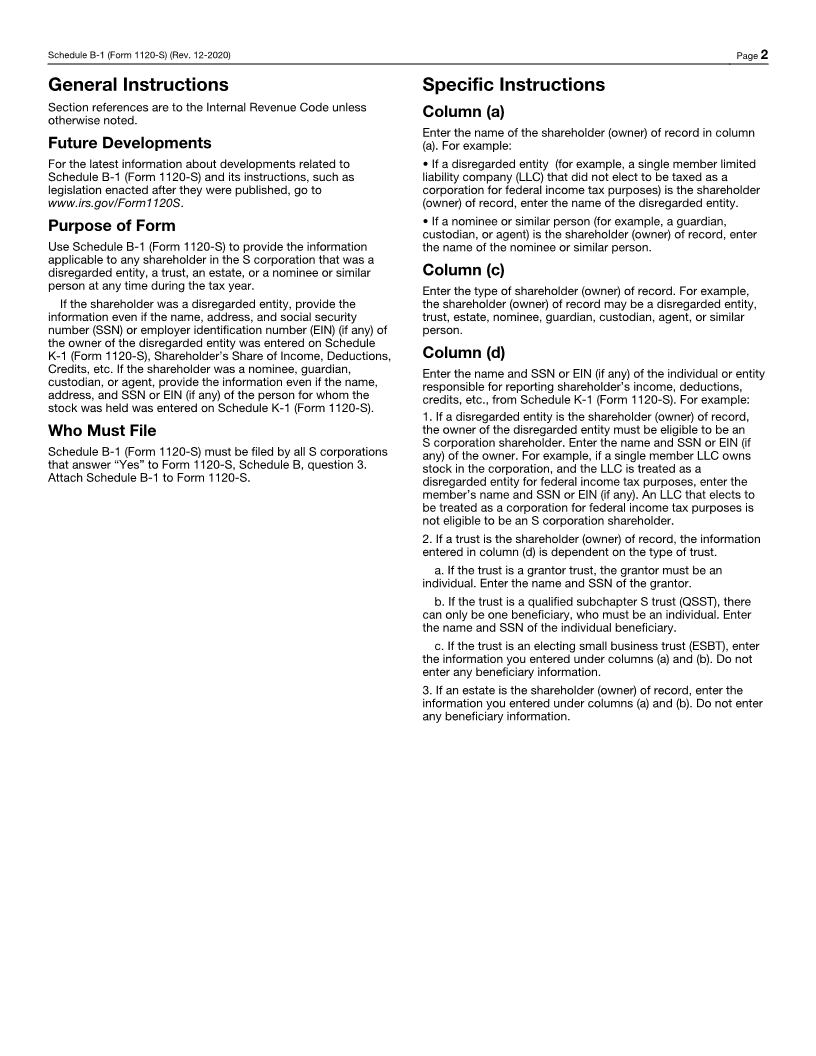- 2 -

Enlarge image
|
Schedule B-1 (Form 1120-S) (Rev. 12-2020) Page 2
General Instructions Specific Instructions
Section references are to the Internal Revenue Code unless Column (a)
otherwise noted.
Enter the name of the shareholder (owner) of record in column
Future Developments (a). For example:
For the latest information about developments related to • If a disregarded entity (for example, a single member limited
Schedule B-1 (Form 1120-S) and its instructions, such as liability company (LLC) that did not elect to be taxed as a
legislation enacted after they were published, go to corporation for federal income tax purposes) is the shareholder
www.irs.gov/Form1120S. (owner) of record, enter the name of the disregarded entity.
Purpose of Form • If a nominee or similar person (for example, a guardian,
custodian, or agent) is the shareholder (owner) of record, enter
Use Schedule B-1 (Form 1120-S) to provide the information the name of the nominee or similar person.
applicable to any shareholder in the S corporation that was a
disregarded entity, a trust, an estate, or a nominee or similar Column (c)
person at any time during the tax year. Enter the type of shareholder (owner) of record. For example,
If the shareholder was a disregarded entity, provide the the shareholder (owner) of record may be a disregarded entity,
information even if the name, address, and social security trust, estate, nominee, guardian, custodian, agent, or similar
number (SSN) or employer identification number (EIN) (if any) of person.
the owner of the disregarded entity was entered on Schedule
K-1 (Form 1120-S), Shareholder’s Share of Income, Deductions, Column (d)
Credits, etc. If the shareholder was a nominee, guardian, Enter the name and SSN or EIN (if any) of the individual or entity
custodian, or agent, provide the information even if the name, responsible for reporting shareholder’s income, deductions,
address, and SSN or EIN (if any) of the person for whom the credits, etc., from Schedule K-1 (Form 1120-S). For example:
stock was held was entered on Schedule K-1 (Form 1120-S).
1. If a disregarded entity is the shareholder (owner) of record,
Who Must File the owner of the disregarded entity must be eligible to be an
S corporation shareholder. Enter the name and SSN or EIN (if
Schedule B-1 (Form 1120-S) must be filed by all S corporations any) of the owner. For example, if a single member LLC owns
that answer “Yes” to Form 1120-S, Schedule B, question 3. stock in the corporation, and the LLC is treated as a
Attach Schedule B-1 to Form 1120-S. disregarded entity for federal income tax purposes, enter the
member’s name and SSN or EIN (if any). An LLC that elects to
be treated as a corporation for federal income tax purposes is
not eligible to be an S corporation shareholder.
2. If a trust is the shareholder (owner) of record, the information
entered in column (d) is dependent on the type of trust.
a. If the trust is a grantor trust, the grantor must be an
individual. Enter the name and SSN of the grantor.
b. If the trust is a qualified subchapter S trust (QSST), there
can only be one beneficiary, who must be an individual. Enter
the name and SSN of the individual beneficiary.
c. If the trust is an electing small business trust (ESBT), enter
the information you entered under columns (a) and (b). Do not
enter any beneficiary information.
3. If an estate is the shareholder (owner) of record, enter the
information you entered under columns (a) and (b). Do not enter
any beneficiary information.
|

